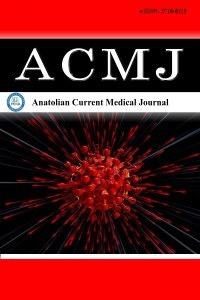The role of serum lipoprotein levels in predicting independent short-term mortality In COVID-19 patients
The role of serum lipoprotein levels in predicting independent short-term mortality In COVID-19 patients
COVID-19, high-density lipoprotein, low-density lipoprotein, cholesterol triglyceride, mortality,
___
- Laurila A, Bloigu A, Nayha S, et al. Chronic Chlamydia pneumoniae infection is associated with a serum lipid profile known risk factor for atherosclerosis. Arterioscler Tromb Vasc Biol 1997; 17: 2910-3.
- Guirgis FW, Donnelly JP, Dodani S, et al. Cholesterol levels and long-term rates of community-acquired sepsis. Crit Care 2016; 20: 408.
- Kaysen GA, Ye X, Raimann JG, et al. .Monitoring dialysis outcomes (MONDO) Initiative Lipid levels are inversely associated with infectious and all-cause mortality: international MONDO study results. J Lipid Res 2018; 59: 1519-28.
- Saballs M, Parra S, Sahun P, et al. HDL-c levels predict the presence of plevral effusion and the clinical outcome of community-acquired pneumonia. Springer plus 2016; 5: 1491.
- Wu Z, McGoogan JM. Characteristics of and ımportantlessons from the coronavirus disease 2019 (COVID-19) outbreak in China: summary of a report of 72314 cases from the Chinese center for disease control and prevention. JAMA 2020; 323: 1239-42.
- Sorokin AV, Karathanasis SK, Yang ZH, et al. COVID-19 -Associated dyslipidemia: Implications for mechanism of impaired resolution and novel therapeutic approaches. The FASEB Journal 2020; 34: 9843-53.
- Wang G, Zhang Q, Zhao X, et al. Low high-density lipoprotein level is correlated with the severity of COVID-19 patients: an observational study. Lipids Health Dis 2020; 19: 204.
- Ruan Q, Yang K, Wang W, et al. Clinical predictors of mortality due to COVID-19 based on an analysis of data of 150 patients from Wuhan, China. Intensive Care Med 2020; 46: 846-48.
- Wu D, Shu T, Yang X, et al. Plasma metabolomic and lipidomic alterations associated with COVID-19. Natl Sci Rev2020; nwaa086.
- Abu-Farha M, Thanarj TA, Qaddoumi MG, et al. The role of lipid metabolism in COVID-19 virus infection and as a drug target. Int J Mol Sci2020; 21: 3544.
- Cao X, Yin R, Albrecht H, Fan D, Tan W. Cholesterol: a new game player accelerating vasculopathy caused by SARS-CoV-2?.Am J Physiol Endocrinol Metab2020; 319: E197-2.
- Tanaka S, De Tymowski C, Assadi M, et al. Lipoprotein concentrations over time in the intensive care unit COVID-19 patients: Results from the ApoCOVID study. PLoS One 2020: 15: e0239573.
- Qin C, Minghan H, Ziwen Z, Yukun L. Alteration of lipid profile and value of lipids in the prediction of the length of hospital stay in COVID-19 pneumonia patients. Food Sci Nutr 2020; 8: 6144-52.
- Yayın Aralığı: 6
- Başlangıç: 2019
- Yayıncı: MediHealth Academy Yayıncılık
Murat YILDIZ, Deniz ÇELİK, Figen AKOĞLAN, Yeşim Güllü COŞKUN, Hatice BALDEDE
Orbital MRI in thyroid-associated orbitopathy
Muhammed Akif DENİZ, Mehmet TURMAK, Zafer PEKKOLAY, Salih HATTAPOĞLU
Changing profile of infective endocarditis during 31-year time course in a tertiary care hospital
Ali Erkan DUMAN, Yesim CETİNKAYA SARDAN
Hamide Ayben KORKMAZ, Ahmet KARAOĞLU, İlkay CEYLAN
Assessment of failed spinal anesthesia for cesarean section during COVID-19 pandemic
Ferhat ÇAY, Hasan Basri ÇETİNKAYA
Feyza AYHAN, Oral MENTEŞ, Murat YILDIZ, Güler ERASLAN DOĞANAY
Rubella, cytomegalovirus and toxoplasmosis seroprevalence in pregnants in Çorum Province
Prognostic significance of controlling nutritional status (CONUT) score in hemodialysis patients
